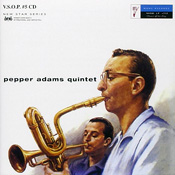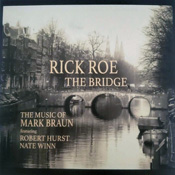Recent Recordings by Area Jazz Artists
Among those who have chosen to play jazz on the baritone saxophone, Pepper Adams will always be counted among the true originals, regardless of style. Born in Highland Park, MI, he spent much of his youth out of state, but at age 16 he relocated to Detroit, where he took up the baritone sax and was soon playing with Lucky Thomson, Donald Byrd, Thad Jones, Kenny Burrell, and Wardell Gray. After working in and eventually leading the band at the Bluebird Inn and then at Klein’s Show Bar he left town in 1956 as a member of Stan Kenton’s big band and eventually settled in Los Angeles. A true Detroit jazzer and originally an avid follower of Charlie Parker, he developed a powerful post-bop style that eventually led him to play and record with most of the greatest musicians in the music, but he retained his Motown roots, co-leading combos with Byrd and Jones.

In 1957, while still in LA, Adams recorded the first album under his own name for Mode, a short-lived record label that produced 28 LPs in 1957, mostly dedicated to musicians associated with the local studio scene. Pepper Adams Quintet (Mode 112) found the baritonist in the company of Stu Williamson, trumpet; Carl Perkins, piano; Leroy Vinnegar, bass; and Mel Lewis on drums, and now it is being reissued as an audiophile LP by a new label, Gammaut, remastered by the respected Bernie Grundman.
At the time, modern jazz baritone sax playing was dominated by the Lester Young-inspired softer sounds of players such as Serge Chaloff, Cecil Payne, Bob Gordon, or Gerry Mulligan. Yet Adams had already developed a harder timbral profile and a rhythmically complex and harmonically more explanatory manner of improvising. By 1957 Adam’s style had already coalesced so that, listening to this recording, he is immediately identifiable. Here, he was accompanied by some of the finest players on the West Coast. Stu Willamson was an established brass player who, in addition to the trumpet, was often featured on the valve trombone. His lithe melodic soloing provides a nice foil to Pepper’s more angular and muscular approach, while the well-known bassist and drummer provided a solid swinging characteristically smooth carpet for the others to play upon and against. One of the joys of this record is the consistently stellar piano work of Carl Perkins; only 27 at the time but tragically with only eight more months to live. He was an excellent accompanist, perfectly suited for Adams’ rhythmic style and his wonderfully structured solos are a joy to hear.
Of the five tunes heard here, three are classic standards and two come from the leader’s pen. The opening “Unforgettable,” one of the earliest jazz covers of the song made famous by Nat King Cole, taken at a somewhat faster but laid-back tempo than the famous recording, finds Adams soloing in a relaxed mood, laying back on the beat. He then takes on another tune that was in vogue at the time, “Baubles, Bangles, & Beads,” adapted from a Borodin string quartet for the musical Kismet, that had been a hit for Peggy Lee. Here, the ballad was transformed into an up-tempo romp, with Adams as well as the rest of the group to explore the changes in rapid powerful style, with the leader setting the tone in his long initial solo. The same general atmosphere continues in the leader’s “Freddie Froo,” but here Williamson takes the first honors, soloing in a pensive melodic manner. The trumpet lays out for the one ballad of the album, “My One and Only Love,” which belongs completely to Adams, whose rich sound, harmonic inventiveness, and emotive creativity are fully on display.

Rick Roe likes monographic composer-pianist recitals; his first CD consisted exclusively of works by Thelonious Monk and remains to this day one of the few truly creative non-imitative albums of his works. Earlier this year he released Tribute: The Music of Gregg Hill, one of the many explorations of that man’s cornucopia of compositions that have appeared of late. On his brand-new CD, The Bridge: The Music of Mark Braun, with Robert Hurst on bass and Nate Winn on drums, Roe takes on the music written by his old friend Mark Braun, also known as Mr. B.
Braun first came on the scene as a blues pianist who learned from some of the original creators of boogie blues such as Boogie Woogie Red and Little Brother Montgomery, mainly playing solo, exhibiting a singular powerful left-hand beat. Over the years, his never ceasing curiosity led him to explore all manner of piano styles and to collaborate with jazz musicians young and old, including experienced masters such as drummer J. C. Heard. In this way, he has managed to integrate various influences into a personal pan-stylistic vision, grounded, to be sure, in his youthful fascination with the blues, but enriched by a variety of more modern harmonic and melodic approaches. Rick Roe’s musical roots are quite different, rooted in the bebop traditions that are very much a part of the Detroit jazz scene, watered by early study with the trumpeter Louis Smith who had begun his career with Horace Silver. Years spent as the house pianist at the Bird of Paradise jazz club allowed him to expand his repertoire and accompaniment skills but also gave him the opportunity to play with some of the best local and visiting soloists. In today’s jazz world, which is often rigidly divided into stylistic and epochal corrals, one would think that Braun and Roe would have little in common. In the Detroit and Ann Arbor area, however, musical interaction and camaraderie are much more forgiving, and the two have been friends and mutual admirers, and sometime collaborators for years.
The choice of the fourteen songs on the album accentuates the broad variety of Braun’s compositional skills, reminding us of his love of melody but also highlighting their rhythmic and emotive variety that chart the development of his art from traditional blues to a unique timeless stylistic integration, filled, as Roe notes in his liner notes, “with jazz, gospel, funk, pop, and country music influences.” Several of the tunes have been recorded more than once by the composer while others will be well known to those who have followed his career. When listening to the former, one can appreciate how Roe has put his own stamp on them while respecting the composer’s conceptions. On his 2009 album Joybox, Mr. B laid down “Circle Blues” as a slow wistful tune that begins with an out of tempo intro; Roe begins in similar fashion, but is less pensive, digging in harder, even if his improvisations for the most part keep to the original model, with just the occasional modernism. Braun has recorded “Deep Excavation” several times. With Paul Keller, he added a bass intro, which now has become longer, with Hurst expanding it in his own virtuoso fashion and then, when soloing, Roe acknowledges some of Braun’s chordal exploration but then starts to embellish with single lines that take the harmony out elsewhere. The recital ends with “My Sunday Best,” perhaps B.’s best-known composition, written for arwulf arwulf, who for many years had a Sunday morning radio show on WEMU, the title and final tune of Mr. B’s first CD. Roe stays true to the churchlike intro and to the complex arrangement: when the boogie starts, he shows off his old-fashioned left-hand chops but then when the variations start, he lets loose his modern jazz manner before returning to Braun’s customary climactic bravura variations in a spectacular tribute to his old friend. Throughout, Roe imaginatively juxtaposes the composer’s versions with his own creativity, balancing Braun’s characteristics with his own jazz inflections and judicious tempo adjustments.
Roe and B come from very different musical worlds but they meet here in a manner that exemplifies the often-cited dictum expressed by Duke Ellington, but also attributed to others, including Rossini, that “there are simply two kinds of music, good music and the other kind.”